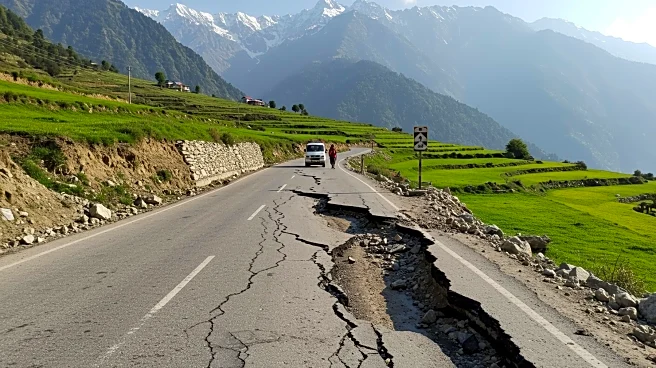What's Happening?
The Kiratpur-Manali National Highway, once a vital route for tourism and agriculture in Himachal Pradesh, is now a source of distress due to recurrent landslides and flooding. The highway, particularly the segment between Mandi and Kullu, has suffered significant damage, affecting travel and transport. Initially, the highway facilitated smooth movement from Chandigarh to Manali, boosting tourism and providing farmers with better access to markets. However, since 2023, monsoon rains have caused severe damage, leading to road closures and traffic snarls. Tourists face long delays or cancel trips, impacting local businesses, while farmers experience losses as their produce spoils during transit.
Why It's Important?
The damage to the Kiratpur-Manali National Highway has significant implications for the local economy. Tourism, a major source of income for the region, is severely affected as travelers avoid the area due to unpredictable road conditions. This impacts hotels, restaurants, and other businesses reliant on tourist traffic. For farmers, the highway's instability means delayed transport of perishable goods, leading to financial losses and stress. The situation highlights the need for infrastructure resilience in regions prone to natural disasters, as well as the importance of reliable transportation routes for economic stability.
What's Next?
Stakeholders are urging for a long-term solution to the highway's issues. Suggestions include constructing protective galleries or tunnels in landslide-prone areas to ensure safer travel. The National Highways Authority of India is working on restoring the road, but the challenging terrain complicates efforts. Until a permanent solution is found, the region's tourism and agriculture sectors remain vulnerable to weather-related disruptions.
Beyond the Headlines
The ongoing challenges with the Kiratpur-Manali National Highway underscore broader issues of infrastructure planning and environmental management. The construction methods that contributed to the highway's instability raise questions about sustainable development practices. Addressing these concerns could lead to more resilient infrastructure that better withstands natural disasters, benefiting both the local economy and the environment.












